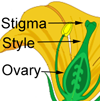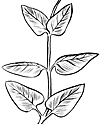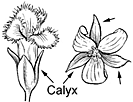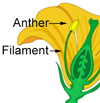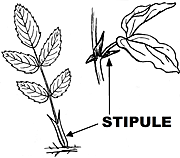Arabian Coffee
Coffea arabica
Madder family (Rubiaceae)
Post-Cook introduction
Coffee, the source of one of the world’s most popular beverages, is an introduced shrub or sometimes a small tree scattered on moist lower mountain slopes and grown in plantations, mainly near Kona, Hawaii. Generally a compact shrub 5–10 ft (1.5–3 ) high, but if not pruned it becomes a small tree 12–15 ft (3.7–4.6 ) high and 3 inches (7.5 ) in trunk diameter, with spreading foliage.
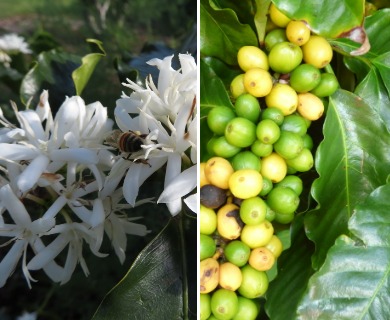
©2018 Forest And Kim Starr
Leaves hairless, with leaf-stalks of 1⁄4–1⁄2 inch (6–13 ). Blades elliptical, 3–7 inches (7.5–18 ) long and 1 1⁄2–2 3⁄4 inches (4–7 ) broad, long-pointed at and short-pointed at base, upper surface and edges often slightly wavy, a little thickened shiny dark green with sunken veins on upper surface: paler green beneath.
Flowers are many, fragrant, several together on stalks of 1⁄8 inch (3 ) at leaf bases along twigs, about 1 1⁄4 inches (3 ) across the five long white consists of five minute teeth on green tubular base () less than 1⁄8 inch (3 ) long; white and showy, with narrow cylindrical tube 3⁄8–1⁄2 inch (10-13 ) long and five widely spreading narrow pointed 5⁄8 inch (15 ) long; five, white, inserted in mouth of tube; and with two-celled inferior and slender two-forked white
Berries elliptical, 1⁄2–5⁄8 inch (13–15 ) long, red, containing thin fleshy pulp and two (sometimes one) elliptical seeds 5⁄16–1⁄2 inch (8–13 ) long, flattened on inner surface. There are about 1000 coffee beans to a pound (2208 to a kilo). In Hawaii, flowering is mainly in spring and the coffee harvest season from September to January with peak in November.
The wood is whitish, hard, heavy, and tough, seldom used.
Coffee is an important agricultural crop in many tropical regions. The seeds, which contain caffeine, are roasted and ground to produce the familiar drink. This species is the most widely grown of several and has many cultivated varieties. Elsewhere, classed as a honey plant, producing white honey with a characteristic flavor.
It is reported that coffee was introduced into the New World first to Suriname by the Dutch in 1714. The same year a tree was presented to King Louis XIV of France as a peace gesture during the signing of the Treaty of Utrecht. From that royal tree, seedlings were smuggled to Brazil in 1727. Nearly a century later, in 1813, coffee was first planted in Hawaii by Don Marin. In 1818, missionary Samuel Ruffles grew ornamental shrubs at Kona. Many plantations were established mainly between the years 1840 to 1856. Losses from insects and fungus disease caused abandonment of most plantations and replacement by sugar cane.
Coffee is still produced commercially in a narrow belt on the west side of the Island of Hawaii. Kona coffee, known for its unique flavor, is grown on many small farms in a narrow subtropical belt with high rainfall at 1200–2000 ft (366–610 ). A coffee mill is located near the seaside village of Napoopoo on Kealakekua Bay. The Kona Coffee Festival in early November celebrates the coffee harvest season.
In Hawaii, coffee is naturalized locally on moist lower mountain slopes of the islands of Kauai, Oahu, and Hawaii.
Range
Native of Ethiopia but early introduced into Arabia (14th century) and extensively planted and escaping or naturalized through the tropics. In the New World, coffee is grown commercially from Mexico and Central America south to Brazil and through the West Indies including Puerto Rico and the Virgin Islands. Planted also as a novelty or ornamental shrub in southern Florida and southern California.
Other common names
Kona coffee, Arabian coffee

